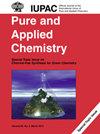利用沉降岐球菌的生物絮凝剂进行纳米铜粒子的生物合成和表征
IF 2
4区 化学
Q3 CHEMISTRY, MULTIDISCIPLINARY
引用次数: 0
摘要
微生物絮凝剂在纳米粒子合成中的应用因其生态友好性而吸引了科学家们的关注。本研究的主要重点是利用非致病性微生物 Kytococcus sedentarius 生产生物絮凝剂,对纳米铜粒子进行生物合成和表征。利用紫外-可见光谱(UV-vis)、傅立叶变换红外光谱(FT-IR)、扫描电子显微镜(SEM)、透射电子显微镜(TEM)、X 射线衍射仪(XRD)和热重分析(TGA)对形成的纳米铜粒子(CuNPs)进行了分析。经过提取和纯化,在 1 升培养发酵混合物中产生了 2.4 克生物絮凝剂。在 CuNP 的生物合成过程中,培养 24 小时后出现蓝色变化,表明其成功形成。在合成的 CuNPs 中发现了多种元素,即 C、O、Cu、P、Ca、Mg 和 Al,其中碳元素占 25.23%(重量比),氧元素占 20.13%(重量比),铜元素占 23.37%(重量比)。产品的 SEM 和 TEM 图像显示其为不同大小和形状的团聚体。热重分析(TGA)显示,CuNPs 具有热稳定性,在 900 °C 温度下重量保留了 70%,重量损失了 30%。生物合成的 CuNPs 的傅立叶变换红外光谱包含多种与糖和蛋白质有关的官能团,即羟基、胺基、羧基和 559 cm-1 处的典型 Cu-O 键。晶体尺寸估计为 28.3 nm,与铜标准的 JCPDS 卡 89-5899 号一致,确认了正确的峰方向。紫外-可见分析显示吸收峰为 275 nm,这证实了使用生物絮凝剂合成的 CuNPs。本文章由计算机程序翻译,如有差异,请以英文原文为准。
Copper nanoparticle biosynthesis and characterization utilizing a bioflocculant from Kytococcus sedentarius
The application of microbial flocculants in nanoparticle synthesis is attracting scientists to utilize them due to their eco-friendliness. This study was mainly focused on biosynthesizing and characterizing copper nanoparticles from a non-pathogenic microorganism Kytococcus sedentarius to produce bioflocculant. The formed copper nanoparticles (CuNPs) were analyzed using UV–vis spectroscope (UV–vis), Fourier transform infrared (FT-IR) spectroscopy, scanning electron microscope (SEM), transmission electron microscopy (TEM), X-ray diffractometer (XRD) and thermo-gravimetric analysis (TGA). After extraction and purification, 2.4 g was produced from bioflocculant in a 1 L culture fermentation mixture. During CuNP biosynthesis, a blue color change was obtained after 24 h of incubation indicating their successful formation. A variety of elements namely, C, O, Cu, P, Ca, Mg and Al were found in the as-synthesized CuNPs with 25.23 % (wt) carbon, 20.13 % (wt) of oxygen and 23.37 % (wt) of Cu element. SEM and TEM images of the product depicted it to be agglomerated with different size and shapes. The TGA showed the CuNPs to be thermal stable as 70 % weight was retained at 900 °C with 30 % weight lost. FT-IR spectrum of the biosynthesized CuNPs contains a variety of functional groups related to sugar and proteins namely, hydroxyl, amine, carboxyl groups and a typical Cu–O bond at 559 cm−1 . The crystallite size was estimated to be 28.3 nm, which is in line with JCPDS card no. 89–5899 of copper standard confirming the correct peak orientation. UV–vis analysis revealed the absorption peak to be 275 nm which confirms synthesis of the CuNPs using a bioflocculant.
求助全文
通过发布文献求助,成功后即可免费获取论文全文。
去求助
来源期刊

Pure and Applied Chemistry
化学-化学综合
CiteScore
4.00
自引率
0.00%
发文量
60
审稿时长
3-8 weeks
期刊介绍:
Pure and Applied Chemistry is the official monthly Journal of IUPAC, with responsibility for publishing works arising from those international scientific events and projects that are sponsored and undertaken by the Union. The policy is to publish highly topical and credible works at the forefront of all aspects of pure and applied chemistry, and the attendant goal is to promote widespread acceptance of the Journal as an authoritative and indispensable holding in academic and institutional libraries.
 求助内容:
求助内容: 应助结果提醒方式:
应助结果提醒方式:


